Whether talking with customers, employees, investors, or community leaders, knowing how to read the room can help you achieve your business goals. Watching and listening to other people can give you “ideas, information and inspiration,” says Marcus Lemonis.


For example, when the two owners of an all-natural cleaning products business were making a sales pitch to a major hotel, Marcus realized the executives were not “wowed” by the presentation. Knowing how to read the room, he stepped in and offered to demonstrate the products’ effectiveness by cleaning a bathroom – a riveting move that captured their full attention.
Why You Should Know How to Read the Room
As a business owner, there will be many times when you want something to achieve your goals. That might be making a pitch to a prospective client, preparing a financial presentation for an investor or a bank lending officer, or letting your team know about a new process in the workplace. Regardless of your skills as a communicator, you need to know how to read the room in order to see how well your message is getting through.
Observing how your audience is responding can help you adjust a sales pitch in real time, address any objections, or open things up for questions. Or if you see that everyone is happily nodding their heads, you could cut to the chase and ask for the deal. Being able to engage your audience effectively can also build rapport and help you earn their trust. That can be particularly important when communicating with employees, business partners or other team members that you see on a regular basis.
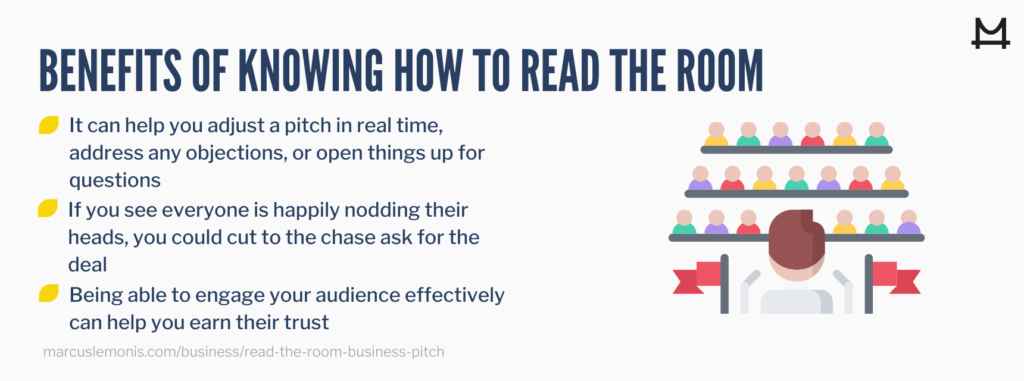
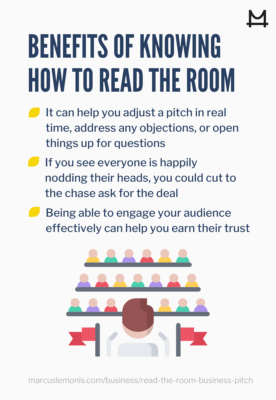
A Hit and a Miss
While some business owners seem to have an intuitive knack for observing peoples’ reactions, others find it difficult to read the room. Not long ago, Marcus helped two novice entrepreneurs launch a new company offering fashionable cases for mobile phones. He also arranged a meeting with the executives of a national wireless company to discuss an exclusive partnership with proprietary designs. At the meeting, Marcus focused on reading the room. He could see that the execs paid close attention and seemed to like the designs. The result was an order for 38,000 cases that would be distributed to the wireless stores nationwide – a big win for the fledgling company.
But not every business owner achieves the same result. While in college, two buddies started a sock company and grew it into a multi-million dollar business. Marcus wanted to test their marketing skills with other products and arranged a “Marcus Lemonis Community” meeting with several other small business owners. But rather than read the room and interact with the audience, the owners of the sock company turned the session into a negative emotional event for everyone. They showed little knowledge about the products being presented, were dismissive of their offerings, and asked the business owners for confidential financial information. Not surprisingly, the other owners walked out vowing not to do business with the sock company.

Learning How to Read the Room
As a business owner, you can learn how to read the room. It’s a skill that you can develop with a little training and lots of practice. In fact, you probably already know a lot of the basics from observing your family members and friends. Certainly, you wouldn’t ask for a favor if your spouse or partner is in a bad mood! Here are some tips for developing this skill.
Observe Your Audience
The first step in learning how to read the room is to focus your powers of observation. Look around to see who is smiling and who seems to be unhappy. If it’s an in-person meeting, look at how individuals position themselves. Can you pick out the decision maker based on where people are sitting or standing? What does their body language indicate? Are they leaning forward and paying attention, studying their mobile phones or getting ready to bolt out the door?

Reading the room is more challenging in a virtual meeting, but not impossible. Pay attention to facial expressions and watch the eyes. That will give you important clues about the attendees. For instance, someone who looks down or to the side while you talk may be answering an email or text rather than paying attention to your words. From time to time, you could take a brief pause – perhaps for a sip of water – and take a moment to observe what’s happening in the room.
Limit Your Talking
It’s almost impossible to read the room while you are talking. So, do a quick check on yourself and the attendees before you dive into your talk. Do you know the key points you want to convey? Are you ready to handle the most likely questions or objections? Are you clear about your preferred outcome?
Today, almost everyone seems to have short attention spans. So try to get your key points across as concisely as possible in most situations. But if you know how to read the room, there might be occasions where your audience wants you to drill down into your topic, perhaps with technical details or product specifications.

Be a Role Model
While speaking with an audience, you should be aware of your own verbal tone, body language and energy level. Stand up straight, make eye contact, move around the room and gesture, if that’s part of your style. In other words, be a role model for your audience. After all, if you sound bored or disinterested, your audience will start tuning you out. Instead, you want everyone in the room to get a positive “reading” of you!
Engage the Audience
Depending on the nature of your talk, you can open up the conversation for questions from the audience or ask for their comments. As you listen, pay attention to the emotional tone of their words for clues to their responsiveness. You can also take a brief pause in your comments to look around the room. In a meeting with employees or business partners, you could go around the room and ask each individual for a response. That’s a good way to engage them in the discussion and make sure their voices are heard.
Another effective technique for engaging the audience is to ask attendees to repeat your key points of your talk. This can be a good way to be sure employees understand a change in a company policy or process, for example, and this can be done in a fun way. However, you probably wouldn’t want to approach an investor or a sales prospect in the same way. Instead, you can summarize your key points and thank them for their attention.

Respond to the Situation
Sometimes you can almost feel a shift in your audience’s attention. People might start looking at their watches or cellphones, indicating they are ready to leave. Or something you say might provoke an angry outburst or a sudden quiet. If you observe this occurring, you should respond to the changing situation, rather than continue with your planned remarks. You might say something like, “I can tell you didn’t like my last comments, so let’s talk about it.” Or if time is running low, you could say, “I see we are almost out of time. Let me know what you thought about my talk, and we can continue our conversation in a few days.”
Check Your Observations
You might be a master at reading the room, but miss a subtle point along the way. Don’t be afraid to ask your managers or partners what they thought of the audience’s response to your talk. Depending on their comments, you might draw up a slightly different game plan for your follow up actions. Getting that kind of third-party feedback can often be helpful in motivating your audience and getting them moving in the desired direction.
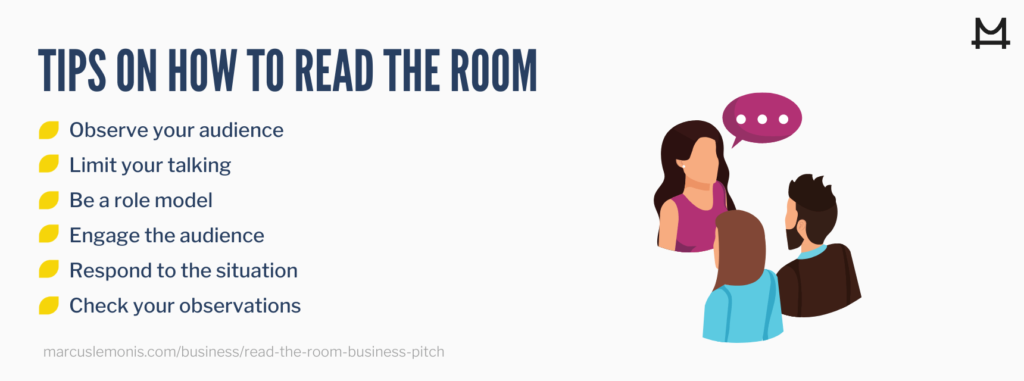
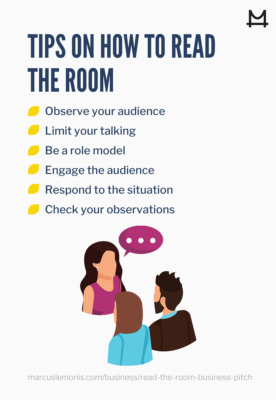
More Tips on How to Read a Room
As Marcus says, you need to “Trust the process.” When learning how to read the room, that means understanding how to find the right balance between making your key points and observing how your audience is responding.
- Pay Close Attention to Nonverbal Cues
- Identify Positive Behaviors
- Watch Where Everyone is Sitting or Standing
- Be Sure to Engage the Audience
- Become a Role Model
- Ask Open-Ended Questions
- Make Sure They Understand your Key Points
- Don’t talk on and on and on. You are almost guaranteed to lose your audience.
- Don’t get distracted. If you lose your train of thought, take a deep breath and retain your focus.
- Don’t look down and read your notes. That’s a boring approach to any conversation and it will put your audience to sleep.
- Don’t focus on yourself. Make your talk relevant to your audience. After all, they want to know what’s in it for them.
- Don’t get fearful or angry. If you start sending out negative energy, you will quickly lose your audience. Any key points you want to make from your talk will be overshadowed by an emotional outbreak.
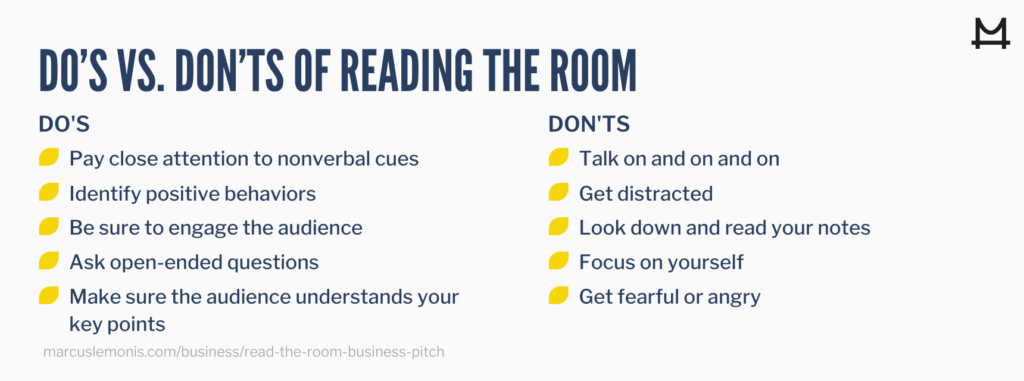
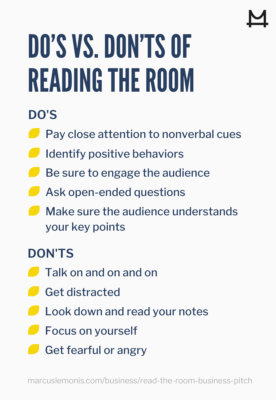
Finally, never become complacent and assume you can always deliver an effective talk. That’s a recipe for failure. Remember that your audience is different every time, and you still need to keep learning how to read the room. As Marcus says, “The key to business isn’t being smarter or wealthier, it’s being able to connect to people and relate to them.”
- What are some things you look for when reading the room?
- What new tips did you learn?





